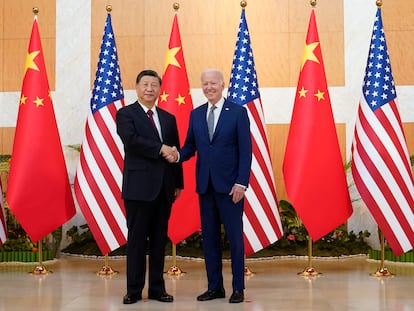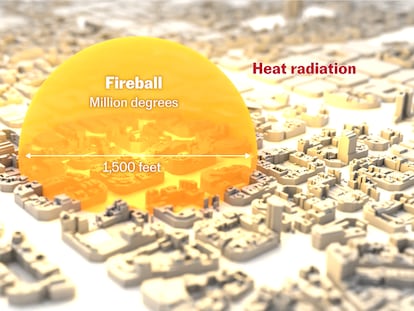In growing arms frenzy, North Korea launched nearly 70 missiles in 2022
Buttressed by renewed support from China and Russia, Kim Jong-un ordered more tests this year than during the 63-year-long regime of his father and grandfather
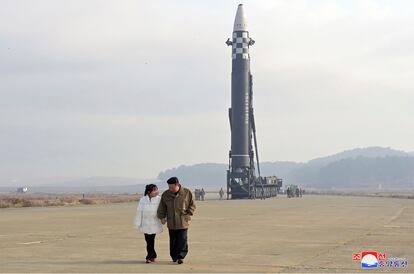
The short-lived conciliatory attitude of the North Korean regime is gone for good. Kim Jong-un – the supreme leader of the country since 2011 – has fired more than 70 missiles over the past year. This is more than double the total amount of tests ordered during the entire 63-year-long regime of his father and grandfather.
The global focus on the war in Ukraine, and the protection at the UN Security Council now afforded by permanent members Russia and China, has given Kim Jong-un a sense of impunity. Following a temporary detente during the Trump administration, the North Korean dictator has returned to a decades-old policy of threatening neighboring South Korea and Japan with weapons tests. Pyongyang has closed the door on any negotiations with Washington to reduce nuclear development.
The lack of transparency and vast amounts of propaganda surrounding the North Korean nuclear program make it difficult to determine the regime’s capacity. However, analysts generally agree that, through its missile tests, the communist government has demonstrated its ability to reach any part of the United States with its intercontinental ballistic missiles.
In 2022, the North Korean Armed Forces tested an enormous missile – Hwasong-17– that is nicknamed “The Monster.” It can reportedly hit practically any part of the planet.
On November 2 – during large-scale military exercises carried out by its regional rivals – Pyongyang fired off 25 missiles. One of them flew over the maritime border between the two Koreas. In addition, the North Korean military launched hundreds of artillery pieces into the sea.
“North Korea always responds to maneuvers with short-range missile launches,” says Jenny Town, the director of North38, a US website that monitors the actions of the North Korean Armed Forces. “But what happened last month is of a magnitude that has never been seen before,” she adds.
Kim Jong-un’s escalated provocations likely are in response to joint military exercises carried out between Japan, South Korea and the United States – the largest exercises since 2017.
Seoul’s response to the North’s provocations has also been more forceful than usual: in early November, three South Korean warplanes fired air-to-surface missiles in the waters off the North Korean coast.
Town stresses that most of East Asia is embroiled in an arms race. She notes that the situation is “unpredictable” – there is a high risk of an accident leading to a confrontation.
A good summary of the situation’s volatility can be found in a statement issued on November 24 by Kim Yo-jong – Kim Jong-un’s younger sister and confidante:
“If they think that with sanctions they can get out of the current dangerous situation, they must really be idiots,” she scoffed, referencing South Korea’s proposal to impose a new round of punishments on North Korea for its ballistic tests.
Since 2006, the North Korean dictatorship has been prohibited from carrying out nuclear or ballistic missile tests. Its constant violations have resulted in countless sanctions – the last round was imposed in 2017. However, over the summer, both Russia and China used their vetoes on the UN Security Council to block any attempt by the Biden administration to expand the sanctions list.
In her statement, Kim Yo-jong justified the regime’s missile tests as part of a “legitimate defense” against maneuvers in the area. She also called the right-wing government in Seoul a “lapdog” and “America’s puppet” and expressed nostalgia for the good old days, when former left-wing president Moon Jae-in facilitated a rapprochement with the North.
In February of 2019 – in a joint effort with then-president Moon – Donald Trump met with North Korea’s supreme leader. He went so far as to say that “Kim and I fell in love.” However, the North Korean delegation offered very few concessions to the Trump administration, while the American delegation refused to sign off on anything short of full denuclearization. With the arrival of Joe Biden to the White House in 2021, the Korean problem receded into the background. The prevailing school of thought in Pyongyang seems to be that negotiating with the United States is fruitless. Relying on old allies such as Russia and China is a safer bet for the regime to maintain total control over 26 million North Koreans.
Washington, Tokyo and Seoul fear that recent North Korean agitation is the preamble to a new atomic test. This would be North Korea’s first since 2017 and the seventh in its history – the only ones that have ever taken place in the 21st century, as the rest of the world has refrained from such activity.
Joe Byrne – a researcher at the Royal United Services Institute, a UK-based defense and security think tank – explains that recent satellite images show that there has been a lot of activity at the Punggye-ri nuclear test center.
“The US and South Korean governments have announced that North Korean preparations [for an atomic test] are complete. Basically, it’s now just a political decision that depends on a single person,” Byrne warns.
Ramón Pacheco Pardo – a professor at King’s College London and the KF-VUB Korea Chair at the Free University of Brussels – believes that Pyongyang is taking advantage of a turbulent international context, dominated by Russia’s invasion of Ukraine and the tensions between Washington and Beijing.
“Right now,” he says, “neither China nor Russia are going to accept any kind of sanction [in the UN Security Council], no matter how many ballistic or nuclear missile tests the North Koreans do.”
Pacheco-Pardo notes that the North Korean nuclear program is a key pillar to the Kim family’s rule. It is a constant warning to the citizenry that the main threats to their lives are not the shortages and the constant risk of famine, but rather, the “imperialism” of the West and its allies. Each rocket offers a political message that Kim can sell internally, while the country suffers from sanctions, natural disasters and the aftermath of the pandemic.
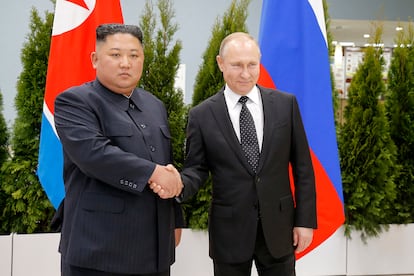
The current harmony between Pyongyang and Moscow is the reflection of conflicting interests in a divided world. Since the invasion of Ukraine, Russian-North Korean relations are at their best point since the Soviet era. Vladimir Putin and Kim Jong-un first met in Vladivostok in 2019, shortly before the rapprochement with Trump fell apart.
In July of this year, North Korea recognized the self-proclaimed Donetsk and Luhansk People’s Republics, which have been illegally occupied and annexed by Russia. In August, Putin sent a letter to Kim in which he underlined his intention to expand their “comprehensive and constructive” relations. US intelligence has accused Russia of buying rockets and millions of artillery pieces from Pyongyang for use in Ukraine.
And last October, the North Korean leader congratulated Putin on his 70th birthday with a letter that praised his vision as a statesman: “With your energetic activity, you have made remarkable achievements towards realizing the grand strategic goal of building a powerful Russia.”
Meanwhile, the Chinese Communist Party – one of the first backers of the Kim family, going back to the Korean War – continues to offer life support to North Korea. Beijing is responsible for 90% of trade with the impoverished country and is the principal provider of aid.
In the eyes of the second-largest power on earth, North Korea is a tool that controls US presence in its backyard. Dr. Nah Liang Tuang – a researcher at the S. Rajaratnam School of International Studies in Singapore – says that China “tolerates and maintains Pyongyang as an ally… not because it really sees it as a brotherly partner, but because it detests the idea of a unified Korea under the government of Seoul, which would maintain an alliance with Washington.” In a scenario of Korean reunification, American soldiers could be right alongside the border of China. At the moment, there are nearly 30,000 American military personnel stationed in South Korea.
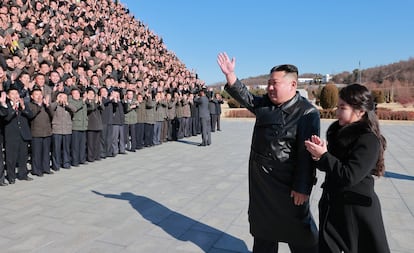
Beijing’s position on North Korea’s escalation closely resembles its pro-Russian stance on the war in Ukraine. Following the missile tests conducted in November, the Chinese Foreign Ministry made a vague call for all the parties in question to “address each other’s concerns in a balanced way through dialogue and consultations.” State outlets in China have blamed the current tensions on the Biden administration, for having exerted pressure on North Korea.
North Korea’s threat to its neighbors south of the 38th parallel is not limited to its nuclear capability. Its conventional weapons keep a huge swath of South Korean territory in check, including Seoul, located barely 30 miles from the Demilitarized Zone.
Some analysts believe that Pyongyang’s use of the nuclear threat is meant to weaken President Biden’s commitment to South Korea and Japan. Former president Trump – now making a new run for the White House – already gave multiple signs during his tenure that he had little interest in protecting traditional American allies.
Recent polls indicate that, following the recent North Korea tests, more than half of South Korean citizens believe that their country should develop its own nuclear program. The majority of Japanese citizens surveyed believe that, at the very least, the possibility of keeping US nuclear weapons on its territory should be discussed.
On November 27, Kim Jong-un claimed that his country aspires to have the most powerful nuclear force in the world. He promoted more than 100 officials and scientists for their work in developing “The Monster.” Clearly, the Kim family won’t be counting on receiving more of the hundreds of millions of dollars that different US governments have given Pyongyang in the past, in exchange for unfulfilled promises of denuclearization. Rather, the North Korean dictator has decided to bet the future of his regime on the protection provided by his atomic program, and by the two gigantic powers with which his country shares a border.
Tu suscripción se está usando en otro dispositivo
¿Quieres añadir otro usuario a tu suscripción?
Si continúas leyendo en este dispositivo, no se podrá leer en el otro.
FlechaTu suscripción se está usando en otro dispositivo y solo puedes acceder a EL PAÍS desde un dispositivo a la vez.
Si quieres compartir tu cuenta, cambia tu suscripción a la modalidad Premium, así podrás añadir otro usuario. Cada uno accederá con su propia cuenta de email, lo que os permitirá personalizar vuestra experiencia en EL PAÍS.
¿Tienes una suscripción de empresa? Accede aquí para contratar más cuentas.
En el caso de no saber quién está usando tu cuenta, te recomendamos cambiar tu contraseña aquí.
Si decides continuar compartiendo tu cuenta, este mensaje se mostrará en tu dispositivo y en el de la otra persona que está usando tu cuenta de forma indefinida, afectando a tu experiencia de lectura. Puedes consultar aquí los términos y condiciones de la suscripción digital.
More information
Archived In
Últimas noticias
Most viewed
- Sinaloa Cartel war is taking its toll on Los Chapitos
- Oona Chaplin: ‘I told James Cameron that I was living in a treehouse and starting a permaculture project with a friend’
- Reinhard Genzel, Nobel laureate in physics: ‘One-minute videos will never give you the truth’
- Why the price of coffee has skyrocketed: from Brazilian plantations to specialty coffee houses
- Silver prices are going crazy: This is what’s fueling the rally
